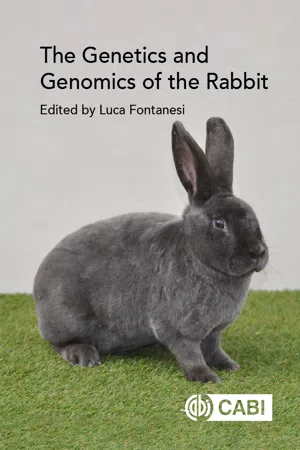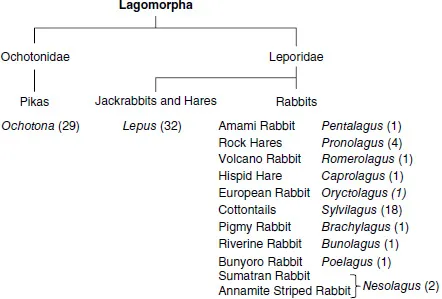
- 344 pages
- English
- ePUB (mobile friendly)
- Available on iOS & Android
Genetics and Genomics of the Rabbit, The
About this book
Rabbits have many uses - as well as being cherished pets, they are bred for their meat and fur, and as laboratory animals. Understanding their genetics and genomics is key to their production and, equally, to their care, welfare and health. Beginning with an introduction to the rabbit, including key information on their evolution, domestication and breed types, this book then concentrates on the genetics and genomics of this valuable animal. This book covers: - Cytogenetics, genetic maps and QTL mapping;- Immunogenetics;- Genetics of coat colour, meat, fibre and fur production, reproduction, disease resistance and more.Concluding with practical applications such as creating transgenic and genome edited rabbits, biotechnical applications and the rabbit as a biomedical model, this book brings this important topic fully up-to-date. It provides an indispensable resource for animal and veterinary researchers and students, as well as rabbit breeders and laboratory scientists.
Frequently asked questions
- Essential is ideal for learners and professionals who enjoy exploring a wide range of subjects. Access the Essential Library with 800,000+ trusted titles and best-sellers across business, personal growth, and the humanities. Includes unlimited reading time and Standard Read Aloud voice.
- Complete: Perfect for advanced learners and researchers needing full, unrestricted access. Unlock 1.4M+ books across hundreds of subjects, including academic and specialized titles. The Complete Plan also includes advanced features like Premium Read Aloud and Research Assistant.
Please note we cannot support devices running on iOS 13 and Android 7 or earlier. Learn more about using the app.
Information
1 The Evolution, Domestication and World Distribution of the European Rabbit (Oryctolagus cuniculus)

1.1 The Order Lagomorpha

Family/genus | Species | Common name |
|---|---|---|
Ochotonidae | ||
Ochotona | O. alpina | Alpine Pika |
O. argentata | Helan Shan Pika | |
O. cansus | Gansu Pika | |
O. collaris | Collared Pika | |
O. coreana | Korean Pika | |
O. curzoniae | Plateau Pika | |
O. dauurica | Daurian Pika | |
O. erythrotis | Chinese Red Pika | |
O. forresti | Forrest’s Pika | |
O. gloveri | Glover’s Pika | |
O. hoffmanni | Hoffmann’s Pika | |
O. hyperborea | Northern Pika | |
O. iliensis | Ili Pika | |
O. koslowi | Koslov’s Pika | |
O. ladacensis | Ladak Pika | |
O. macrotis | Large-eared Pika | |
O. matchurica | Mantchurian Pika | |
O. nubrica | Nubra Pika | |
O. opaca | Kazakh Pika | |
O. pallasii | Pallas’s Pika | |
O. princeps | American Pika | |
O. pusilla | Steppe Pika | |
O. roylei | Royle’s Pika | |
O. rufescens | Afghan Pika | |
O. rutila | Turkestan Red Pika | |
O. syrinx | Qinling Pika | |
O. thibetana | Moupin Pika | |
O. thomasi | Thomas’s Pika | |
O. tutuchanensis | Turuchan Pika | |
Leporidae | ||
(the rabbits) | Brachylagus idahoensis | Pygmy Rabbit |
Bunolagus monticularis | Riverine Rabbit | |
Caprolagus hispidus | Hispid Hare | |
Nesolagus netscheri | Sumatran Striped Rabbit | |
Nesolagus timminsi | Annamite Striped Rabbit | |
Oryctolagus cuniculus | European rabbit | |
Pentalagus furnessi | Amami Rabbit | |
Poelagus majorita | Bunyoro Rabbit | |
Pronolagus crassicaudatus | Natal Red Rock Hare | |
Pronolagus randensis | Jameson’s Red Rock Hare | |
Pronolagus rupestris | Smith’s Red Rock Hare | |
Pronolagus saundersiae | Hewitt’s Red Rock Hare | |
Romerolagus diazi | Volcano Rabbit | |
Sylvilagus | S. aquaticus | Swamp Rabbit |
S. audubonii | Desert Cottontail | |
S. bachmani | Brush Rabbit | |
S. brasiliensis (sensu stricto) | Tapetí, Andean Cottontail, Rio de Janeiro Dwarf Cottontail | |
S. cognatus | Manzano Mountain Cottontail | |
S. cunicularius | Mexican Cottontail | |
S. dicei | Dice’s Cottontail | |
S. floridanus | Eastern Cottontail | |
S. gabbi | Gabb’s Cottontail | |
S. graysoni | Tres María Cottontail | |
... |
Table of contents
- Cover
- Title page
- Copyright
- Contents
- Contributors
- Preface
- 1 The Evolution, Domestication and World Distribution of the European Rabbit (Oryctolagus cuniculus)
- 2 Rabbit Breeds and Lines and Genetic Resources
- 3 The Genome of the European Rabbit and Genomic Tools
- 4 Cytogenetics, Physical and Genetic Maps and QTL Mapping in the European Rabbit
- 5 Immunogenetics in the Rabbit
- 6 Genetics and Molecular Genetics of Coat Colour in the European Rabbit
- 7 Genetics of Fibre and Fur Production in Rabbits
- 8 Genetics and Molecular Genetics of Morphological and Physiological Traits and Inherited Disorders in the European Rabbit
- 9 Genetics of Disease Resistance in the European Rabbit
- 10 Genetics and Genomics of Growth, Carcass and Meat Production Traits in Rabbits
- 11 Biology of Reproduction and Reproduction Technologies in the Rabbit
- 12 Genetics of Reproduction in the Rabbit
- 13 Genetic Improvement in the Meat Rabbit
- 14 Rabbit Research in the Post-genomic Era: Transcriptome, Proteome and Metabolome Analyses
- 15 Methods to Create Transgenic and Genome-edited Rabbits
- 16 Pluripotent Stem Cells in Rabbits
- 17 Biotechnology Applications in the Rabbit
- 18 The Rabbit as a Biomedical Model
- Index